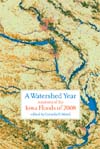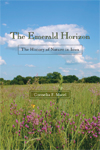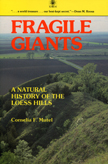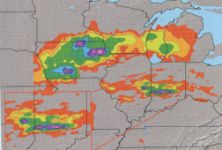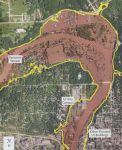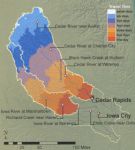A Watershed Year
“A Watershed Year captures the multiple dimensions of flooding and provides compelling arguments for new approaches to provide a way forward in learning to ‘live with floods.’ The June 2008 flooding in Iowa is dissected from the perspective of physical scientists, social scientists, environmental scientists, economists, public policy experts, and engineers. The lessons learned from the 2008 flooding take on particular weight given the recent experiences from the Great Flood of 1993. One of the lessons that will hopefully be learned is that the multidisciplinary approach to flooding adopted in A Watershed Year is an essential aspect of developing effective policies for dealing with floods.”—James A. Smith, Professor, Civil and Environmental Engineering, Princeton University
“A Watershed Year captures the essence of the 2008 eastern Iowa floods in essays written by leading scientists, watershed specialists, and public administrators, many of whom experienced the devastation of the flooding firsthand. It is a must read for both those trying to better understand the circumstances resulting in the historic 2008 floods and those involved in mitigation and planning efforts to deal with future floods. In A Watershed Year Connie Mutel challenges each of us to consider how we should learn to live with floods with a more holistic, sustainable watershed approach.”— Larry J. Weber, Director, IIHR-Hydroscience & Engineering, University of Iowa
“A Watershed Year reminds us that floods, both large and small, will inevitably happen again in the future—perhaps with even greater frequency because of our changing climate. It does a great service to the people of Iowa by collecting concise, informed recommendations to help individuals, communities, and the state say ‘never again’ to the devastation we experienced in the floods of 2008.”—State Senator Rob Hogg
In June 2008, the rivers of eastern Iowa rose above their banks to create floods of epic proportions; their amazing size—flowing in places at a rate nearly double that of the previous record flood—and the rapidity of their rise ruined farmlands and displaced thousands of residents and hundreds of businesses. In Cedar Rapids, the waters inundated more than nine square miles of the downtown area; in Iowa City, where the flood was also the most destructive in history, the University of Iowa’s arts campus was destroyed. By providing a solid base of scientific and technical information presented with unusual clarity and a wealth of supporting illustrations, the contributors to this far-reaching book, many of whom dealt firsthand with the 2008 floods, provide a detailed roadmap of the causes and effects of future devastating floods.
The twenty-five essays fall naturally into four sections. “Rising Rivers, Spreading Waters” begins by comparing the 2008 floods with the midwestern floods of 1993, moves on to trace community responses to the 2008 floods, and ends by illuminating techniques for forecasting floods and determining their size and frequency. “Why Here, Why Now?” searches for possible causes of the 2008 floods and of flooding in general: annual crops and urban landscapes, inflows into and releases from reservoirs, and climate change. “Flood Damages, Flood Costs, Flood Benefits” considers the complex mix of flood costs and effects, emphasizing damages to cities and farmlands as well as potential benefits to natural communities and archaeological sites. “Looking Back, Looking Forward” lays out approaches to managing the floods of the future that are sure to come.
While the book draws most of its examples from one particular region, it explains flooding throughout a much larger region—the midwestern Corn Belt—and thus its sobering yet energizing lessons apply well beyond eastern Iowa. By examining the relationships among rivers, floodplains, weather, and modern society; by stressing matters of science and fact rather than social or policy issues; and by addressing multiple environmental problems and benefits, A Watershed Year informs and educates all those who experienced the 2008 floods and all those concerned with the larger causes of flooding.
Preface and Acknowledgments vii
Introduction xi
Section I Rising Rivers, Spreading Waters
What Causes Floods in Iowa? A. Allen Bradley, Jr. 7
Why Were the 2008 Floods So Large? Witold F. Krajewski and Ricardo Mantilla 19
Iowa City and the Flood Richard A. Fosse 31
The University of Iowa and the Flood Barbara Eckstein and Rodney Lehnertz 39
Linn County and the Flood Linda Langston 45
Forecasting a Record Flood A. Allen Bradley, Jr. 53
Estimating Flood Frequency David Eash 61
Section II Why Here, Why Now?
The Hydrologic Footprint of Annual Crops Michael Burkart 77
The Hydrology of Urban Landscapes Wayne Petersen 87
The Coralville Dam and Reservoir: Design and Operation John Castle 95
The Dam and the Flood: Cause or Cure? Robert F. Sayre 103
Was Climate Change Involved? Eugene S. Takle 111
Section III Flood Damages, Flood Costs, Flood Benefits
Flood Effects on Archaeological Sites Joe Alan Artz and Lynn M. Alex 123
Flood Effects on Modern Communities Cornelia F. Mutel 131
Economic Losses from the Floods Daniel Otto 139
How Did the Floods Affect Farmland?
Richard Cruse, Hillary Olson, and John M. Laflen 147
What’s in Your Floodwaters? Dana Kolpin and Keri Hornbuckle 155
Air Quality Hazards Peter S. Thorne 163
Flood Effects on Natural Communities John Pearson 171
Section IV Looking Back, Looking Forward
When (Not If) the Big One Comes Jack Riessen 185
Watershed-Based Flood Management Douglas M. Johnston 193
Flood Barriers Nathan C. Young and A. Jacob Odgaard 199
Managing Urban Runoff Wayne Petersen 205
Perennial Farming Systems That Resist Flooding
Laura Jackson and Dennis Keeney 215
The Great Flood of 1993: Did We Learn Any Lessons? Gerald E. Galloway 227
Epilogue 235
Notes on Contributors 239
Index 247


